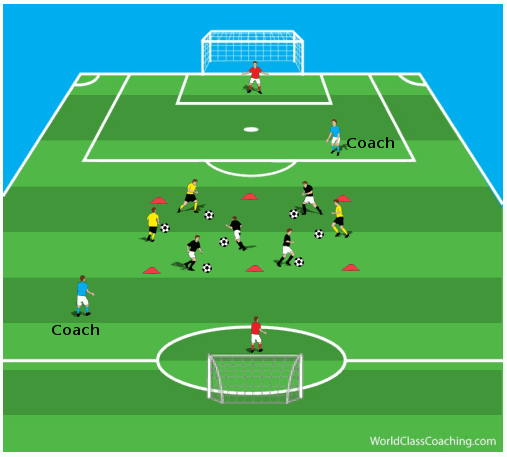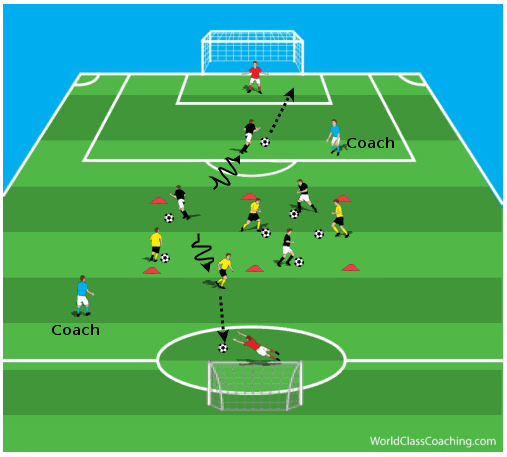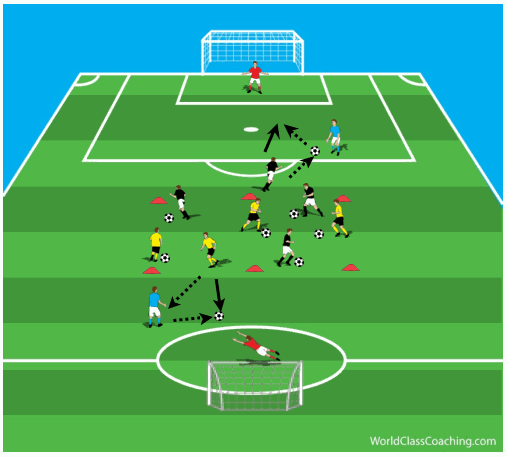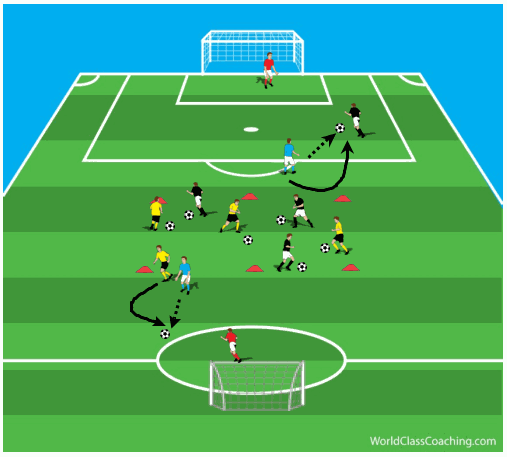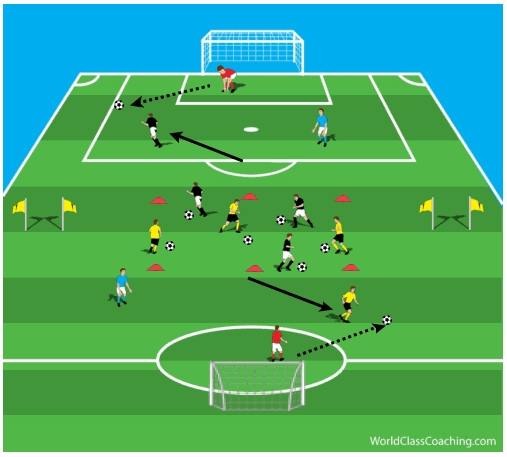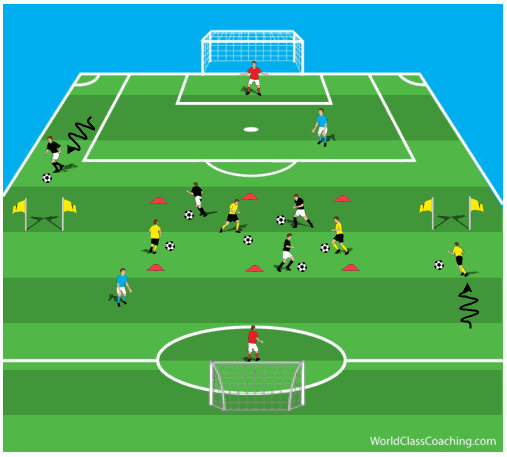By Justin Cresser
After coaching youth soccer for several years, I have observed that shooting from distance is one technique young players frequently have problems with. Players tend to either drag their shots wide, or shoot way over the bar. Like all components of the game, developing good shooting technique requires repetition. However, we frequently observe shooting exercises that have long lines with players waiting to shoot on net; and most coaches will agree that long lines and waiting times are two things we try our best to avoid during training sessions.
Today’s activity is a shooting exercise that circumvents the problem of long lines and standing around by incorporating a dribbling component. The format of the exercise also allows you to simultaneously develop the aerobic capacity of your players. We also include a section that targets speed dribbling and receiving technique.
Set-up and Directions
This activity uses just over half of a regular-sized soccer field for the playing area. Place (or set up with flags or cones) a regular-sized goal on the bottom edge of the centre circle so that it is line, and facing, the goal at the other end of the playing area. Set up a 15 yard by 15 yard grid half way between the 2 goals. Divide your players into 2 equal groups and give each player a number from 1 to however many are in each group (2 players will have the same number). Instruct your players to dribble around inside the square using small touches. Have a coach stand in the space between the goal and the dribbling grid on both sides of the pitch (Figure 1).
When ready, the coach will call out a number. The two players with that number will dribble at pace from the playing grid towards the goal and then take a shot on net (Figure 2). As soon as the shot is taken, have the player retrieve their ball and return to the square to continue dribbling. The coach will tell the players beforehand, which group attacks which net.
Continue this for 90 seconds to 2 minutes and then have the players rest for 60 seconds. This gives a work-to-rest ratio of about 2:1, and is appropriate for developing aerobic endurance. During the sequence, each player should get at least 2 attempts on net. To ensure the activity flows, the coach should call a different number as soon as the player is on their way back to the dribbling area.
Continue this process until you have performed 5 to 6 sequences. However, vary the shooting component of the activity after each 90-second repetition. For instance, have the player perform a wall-pass (Figure 3) or an overlap (Figure 4) with the coach before shooting. By doing this you also ensure the players shoot from a variety of angles.
You can also vary the dribbling component of the activity by having the players perform a variety of skills or fakes (step-overs, turns, cut-backs, etc.) while dribbling.
For the last part of the activity, set up two small (1.5 yards in width) goals using flags or cones, 5 yards in from each side line so that they are in line with the dribbling grid. After calling a number, have your players dribble quickly towards goal and then take a shot into the keeper’s hands. The keeper will then roll the ball out towards the sideline that the player must sprint towards (Figure 5).
Upon reaching the ball, the players must dribble as quickly as possible, but under control, until they have passed through the small goals (Figure 6). They must then re-enter the grid and continue as before.
For this section of the activity to work, the player must shoot into the keeper’s hands. This forces them to concentrate on the accuracy of their shot. (In reality, many shots will still go wide or over the bar, which is why I put this variation as the last one in the routine)
Coaching Points:
- You must ensure that they players keep dribbling while waiting to shoot and that they are doing this at game speed. Make certain they take small touches and keep their heads up while dribbling and encourage them to use both feet.
- As soon as their number is called, the player must dribble towards the goal at speed.
When shooting, the player should approach the ball from a slight angle. Ensure the non-kicking foot lands directly beside the ball and points in the direction of the goal. - Players should make contact with the ball using the laces. The toe of the striking foot should be pointing down and ankle should be locked. Follow through of this leg should be towards the target.
- Players should be compact over the ball during the striking motion.
- In the last part of the activity (Figures 5 and 6), the player should take their first touch so that they are facing forwards (towards the small goal). They must then dribble as quickly as possible but under control.
Justin Cresser – Has coached soccer at various levels both in North America and abroad (Hong Kong and Africa). His most recent position was as the Assistant Technical Director at the Soccer Club of Toronto. He has his National Diploma from the NSCAA and is also a certified strength and conditioning coach.

